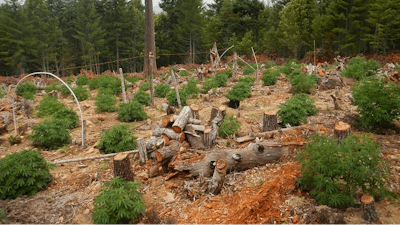
SACRAMENTO, Calif. (AP) — At a state briefing on environmental rules that await growers entering California's soon-to-be-legal marijuana trade, organic farmers Ulysses Anthony, Tracy Sullivan and Adam Mernit listened intently, eager to make their humble cannabis plot a model of sustainable agriculture in a notoriously destructive industry dominated by the black market.
In line with a 2017 study that found marijuana grows are more damaging, plot for plot, than commercial logging in Northern California forests, Anthony said he has seen too many destructive grows. Trash-strewn clearings. Growers heaping fertilizer at the foot of a centuries-old sequoia tree, needlessly endangering it. Wild streams diverted for irrigation.
"It really bothers me when I see some of the other operations, the treatment of the land," he said.
He came from Northern California's remote Lake County with his two business partners for the state-run seminar on just some of the water regulations pot growers must follow when California — the United States' biggest economy, and biggest producer by far in the underground U.S. cannabis market — legalizes recreational marijuana for licensed and permitted growers and sellers in the New Year.
Complying with water laws alone would mean daily record-keeping, permit applications, inspections and more, state officials said. The three growers took in the volume of new environmental rules but were confident they could comply and be ready to go legal with their 1-acre (4,000-square-meter) farm, said Sullivan, sitting between her two male business partners.
"Oh, yeah, it'll be possible," she said. "It'll just be a longer road" than they expected.
Hopes are that legalization will help rein in environmental damage from black-market grows, much of it in Northern California old-growth forests. But early signs are that only a fraction of growers are applying for permits immediately as recreational marijuana becomes legal here.
At the briefing earlier this month, state regulators and consultants hoping to do business with pot farmers notably outnumbered the growers. Rachel Begonia of West Sacramento, one of those consultants, wondered aloud: Where were all the other cannabis growers scrambling to comply with environmental requirements?
As legalization and all of its environmental oversight for farmers who go legal approach in just a few weeks, "either they've got it in the bag, or they're going to try to fly under the radar," Begonia figured.
It's impossible to know exactly how many growers statewide are planning to go legal, two years after Californians voted to legalize recreational marijuana starting in 2018.
California's agriculture department just started accepting applications from growers this week, agency spokesman Steve Lyle said. By midweek, it had received fewer than 200 such applications and approved four, Lyle said.
In Northern California's remote and forested Humboldt County, where an estimated 15,000 pot farmers grow illicitly now on private lands or in so-called trespass grows on tribal lands and publicly held forests, only 2,300 have applied for the required local growing permits, officials say. Humboldt County anchors a swath of California forests known as the Emerald Triangle, estimated to produce almost two-thirds of U.S. cannabis.
Mourad Gabriel, a wildlife biologist in Humboldt County, has spent years documenting and sounding alarms over the damage that black-market marijuana grows wreak in California's sloping old-growth forests and virgin streams.
A container of pesticide exploded in his face at one grow site, Gabriel said. All of the so-called trespass grows Gabriel has inspected have featured illegal diversions of water and some kind of toxic substances, he said.
That's often in the form of old soda or water bottles refilled with widely banned poisons, such as carbofuran, and used to keep bugs or rodents from gnawing on drip irrigation lines or plants.
He and colleagues conducted some of the first surveys of lethal poisoning of significant numbers of California's few hundred remaining fishers, a threatened carnivore. Overall, chemicals at grow sites threaten wildlife ranging from owls to bears to elk, Gabriel said.
He's skeptical California is bringing strong enough enforcement to bear on environmental infractions.
Even if half its growers decide to go legal, California will still have numerous pot farms that flout the rules, Gabriel said. "If even a fraction have pesticide and water use ... that's a concern. A definite concern."
California's Department of Pesticide Regulation is adding about 10 toxicologists and other scientists to its staff of 400 to deal with the pot industry, said Jesse Cuevas, assistant director of programs. "It's not too often we get a multibillion-dollar industry regulated overnight," Cuevas said.
Since marijuana remains illegal under federal law and California's list of allowed bug, mold and rat killers is tied to federal law, no conventional poisons are specifically approved for California cannabis growers. Pot farmers will be allowed only a limited number of conventional pesticides and those associated with organic farming such as cinnamon oil, citronella or traps.
Cannabis sold legally in the state must be tested first for pesticides and other dangers.
California's wildlife department has added about 100 law enforcement officers, scientists and others to deal with the marijuana industry, said Nathaniel Arnold, a deputy chief of law enforcement for the agency.
State and local water boards are adding just under 100 staffers to deal with the industry's water problems, which include contaminating and destroying waterways, said Clint Snyder, assistant executive officer of one regional water board.
Snyder expects many in the black market to wait and see how things go for the first legal growers, like the Lake County business partners.
Ideally, as in the years after Prohibition, trust and market forces will bring growers out of their hideouts in vulnerable hills and forests, and onto the valley floors with the rest of California's farmers.
"The current status quo is unacceptable, and it's very damaging to the environment," Cuevas said. "Any step to regulate the industry is a step in the right direction."






















